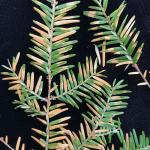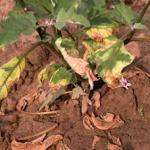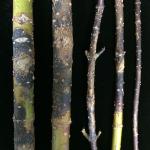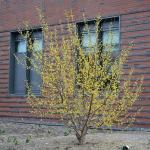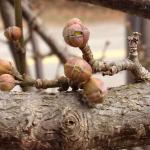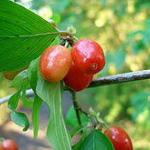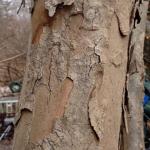A monthly e-newsletter from UMass Extension for landscapers, arborists, and other Green Industry professionals.
To read individual sections of the message, click on the section headings below to expand the content:
Hot Topics
Winter Burn of Hemlock
Symptoms of winter burn on eastern hemlock can range from localized to widespread needle browning in the canopy. The damage tends to develop on the needle tips at first and then spreads towards the base. However, at times it can occur sporadically across the needle.
Widespread needle browning in the canopy can result in serious canopy dieback on landscape trees. The injury is often the result of exposure to extreme cold temperatures and harsh winds. Hemlocks suffering from drought stress may be predisposed, as drought stress is known to inhibit cold acclimation as trees prepare for the dormant season. Additionally, abnormally warm autumn weather can also delay cold acclimation, making hemlocks more susceptible to cold injury. As a shallow rooted tree, hemlocks can be particularly susceptible to drought and thrive in forests with a thick layer of organic matter that buffers against soil drying.
Another way that hemlocks can suffer winter burn is through transpiration during the winter months. Sections of the canopy facing the sun are warmed during bright, sunny winter days, especially when reflective snow cover is present. The warming induces transpiration from the needles. However, since the soil and roots are frozen, water that is transpired from the needles cannot be replaced, leading to drying and desiccation. Recently transplanted trees and those suffering from disease or insect issues (e.g. hemlock woolly adelgid or elongate hemlock scale) can also be at higher risk for winter burn.
Nicholas J. Brazee, UMass Extension Plant Pathologist
Plant Damage from Winter Weather
Late winter into early spring can be an especially challenging time for plants as temperatures fluctuate between winter and spring-like. Some damage, such as broken branches and frost cracks, may already be apparent, but other damage may not be discovered for months. The following are types of winter plant damage to be on the lookout for in the spring:
- Frost cracks occur when bark and wood expand and contract due to warming and cooling caused by sunlight exposure, but temperatures remain cold. The bark contracts faster in response to cooling than the inner wood, causing both the bark and wood beneath it to crack and pop. These cracks will close in warmer weather, but can recur in succeeding winters and can be sites of insect or disease damage.
- Winter burn is most common on the south side of plants where sun is reflected off the snow causing greater warming than the air temperature, leading to an amplified day to night temperature swing. The magnitude of winter burn can be variable with greatest damage occurring when buds are damaged.
- Frost heaving is the result of freezing and thawing cycles which can lift shallow rooted plants from the ground. This leaves the roots unprotected from cold temperatures, frost, and wind. These plants should be replanted as soon as the ground thaws. Damaged or dead buds and leaves can occur when temperatures warm in late winter or early spring and new growth begins. The tender new tissue is killed when the temperature drops and a frost or freeze event occurs.
- Chewing and rubbing damage from rodents, rabbits, and deer can be other obvious damage. Animals feed on the branches and trunks of plants, potentially girdling the plant or even destroying the plant to the ground. Common signs of animal damage include chewing damage, defoliation (especially on lower branches), and girdling of stems and branches. Girdling is the removal of bark and phloem layer from the stem or trunk, which disrupts or prevents the transport of sugars to the roots. Recovery of the plant will be dependent on the extent of damage, with girdling frequently resulting in extensive damage or death of the plant.
- Leaf scorch and desiccation is caused by warmer, windy, sunny days which increase transpiration from evergreen plants but frozen ground prevents adequate water uptake to replace lost moisture. Injury can range from browning of leaf and needle tips to necrosis and defoliation with severe injury. Desiccation injury is most prominent on broadleaved evergreens such as Rhododendron spp. because of the large surface area.
- Salt spray damage can also cause leaf scorch on broadleaf and needled evergreens. It can be distinguished from winter burn or desiccation because damage is generally restricted to the side of the plant close to the sidewalk or street. Foliar, bud, and small branch damage can occur when plants are sprayed by vehicles with snowmelt containing dissolved salts. Snow-cover can help protect plants from direct spray from the road. Salt laden runoff water can damage plants not directly next to streets and sidewalks. Sodium and chloride ions separate when salts are dissolved in water and can be taken up by plants instead of needed soil minerals. This can lead to deficiencies of nutrients such as potassium and phosphorus or chlorine toxicity inside the plants. Rock salt accumulation in landscape beds can lead to physiological drought because the rock salt absorbs available water leading to plant water stress. Salt damage may not be evident until later in the spring as plants emerge from dormancy.
Mandy Bayer, Extension Assistant Professor of Sustainable Landscape Horticulture, University of Massachusetts Amherst
New England Greenhouse Webinar Series
Check out the lastest webinar from the New England Greenhouse webinar series!
UMass Garden Calendar Photo Contest
Ever take a great garden photo and think “this would be perfect for the UMass Garden Calendar?” We are pleased to announce that we are now accepting photos submitted by the public. Submissions will be judged by the calendar team at UMass Extension and may earn a spot in the 2019 Garden Calendar. The deadline for submisions is April 1. For more information visit the Garden Calendar page.
Ticks are active at this time!
Remember to take precautions when working outdoors and to conduct daily tick checks. The UMass Amherst Laboratory of Medical Zoology tests ticks for Lyme Disease and other tick-borne pathogens. Visit the Tick Report website for more information.
Questions & Answers
Q: The tomatoes in my garden did poorly last year - in late summer, the leaves began to turn brown. My friend said she thought it might be Verticillium wilt. What is it, and what should I do?
A: Verticillium wilt is caused by two species of the soil-dwelling fungus Verticillium: V. albo-atrum and V. dahliae. Verticillium has a large host range, including some ornamental trees and shrubs, annual and perennial flowers, fruit, vegetables, and weed species. There are also a number of races in each species, and their individual host ranges may vary. Verticillium forms sclerotia, which are small, hard structures that allow the fungus to survive in the soil for several years. The fungus infects tomato plants through the roots, grows up through the water-conducting tissues of the vascular system, and enters the stem.
Symptoms of Verticillium wilt on tomato include yellowing and/or browning of lower leaves, wilting, stunted growth, and plant collapse. Leaf lesions are sometimes V-shaped. Symptoms usually occur first on half a leaf or on several leaves before the whole plant is affected. Symptoms may appear on the entire plant or on one side. Disease occurs at a range of temperatures from 55 to 86°F, with an optimum of 75°F.
As with any plant health problem, it is very important to get an accurate diagnosis. Although some tomato diseases have distinctive symptoms, many diseases can NOT be accurately identified by visual observation alone. The correct diagnosis is important so that the most effective management practices can be selected. There are numerous factors that can cause tomato leaves to turn brown. These include:
- Vascular diseases such as Verticillium, Fusarium, and Clavibacter. These diseases will cause discoloration of the vascular system in the lowest part of the tomato stem.
- Other fungal cankers, root rot or bacterial pith necrosis.
- Root-knot nematodes.
- Viruses such as tomato spotted wilt (TSWV).
- Severe insect infestation.
- Nutrient deficiency or imbalance.
- Soil pH too high or too low - this affects nutrient availability.
- High soluble salts in the soil.
- Phytotoxicity, AKA chemical burn. Under the right conditions, this can be caused by just about anything sprayed on the leaves: pesticides (even organic ones such as horticultural oil); fertilizer solutions; fish emulsion; etc. The symptoms in this case seem to happen “overnight,” or shortly after application. It is more common in hot weather.
- Excess water. Chronically soggy soil is low in oxygen, and roots need oxygen in order to function properly. Tomatoes need to be watered deeply, but will not thrive in soil that is constantly wet.
- Too little water. Light watering will only wet the top inch or two of soil, and in the heat of the summer much of the water will evaporate from the soil surface before it can percolate down to the root zone.
- Black walnut trees. These produce a substance called juglone, which is toxic to other plants. It may come from walnut leaves that fall into the garden or from tree roots growing under it.
Q: How is a diagnosis of Verticillium wilt arrived at?
A: A sample of crown tissue (lower stem and upper portion of roots) from an infected plant must be cultured in order to arrive at a diagnosis of Verticillium wilt.
When a sample is received at a diagnostic lab, it is carefully examined under increasing degrees of magnification for signs and symptoms of pathogens or insects. Plant tissue may be cultured on selective media in order to coax pathogenic bacteria or fungi to come out and show themselves. Most labs are able to test for a number of common viruses. If a pathogen is not found, a diagnostician will consider environmental or cultural factors like those listed above. The information provided on the submission form accompanying the sample can provide important clues about the conditions in which the plants are growing.
It is also advisable to have your soil tested for nutrient and salt levels in early spring. This will give you a chance to make any necessary amendments before planting. See the UMass Soil and Plant Nutrient Testing Lab website for information on sample submission.
Q: I sent a sample to a diagnostic lab and it was positive for Verticillium. What can I do about it?
A: If you are determined to have fresh homegrown tomatoes, there are several things you can do:
- Grow tomatoes in containers on a porch or platform so that the pots are not in contact with the ground. Use commercial potting medium and not soil from the garden.
- In the garden, remove all plant debris as thoroughly as possible.
- Consider soil solarization before planting. This process involves using clear plastic tarps to heat the soil, and has the added benefit of decreasing the amount of weed seeds. See https://www.rodalesorganiclife.com/garden/soil-solarization for instructions.
- Grow resistant or tolerant varieties of tomatoes. Keep in mind that some varieties may only be partially resistant. Verticillium-tolerant varieties include ‘Jetstar’, ‘Ramapo’, and ‘Better Boy’, among others. The website Vegetable MD Online maintains up-to-date lists of disease resistant vegetable varieties. There are many strains of both Verticillium species and a certain tomato variety may not be resistant to all of them. You may also consult your seed company for more information.
- Make sure plants get adequate nutrition, sun, and water. Keep them free of other diseases and insect pests. Plants that are stressed or unhealthy for any reason are more prone to disease than healthy plants.
- Keep the garden free of weeds as many weed species are also susceptible to Verticillium.
- Keep in mind that several other types of vegetables are also susceptible to Verticillium wilt.
- Grow more vegetables that are not susceptible to Verticillium. These include carrots, parsnips, corn and other grains, onions, and peas.
For information on submitting plants see the UMass Extension Plant Diagnostic Lab website
Angie Madeiras ,UMass Extension Plant Pathologist
Trouble Maker of the Month
Botryosphaeria canker
With spring on the horizon, it’s a good time to start thinking about stem and branch cankering fungi. Specifically, it’s a good time to scout for and prune dead stems and branches on conifers and hardwoods before both the pathogen and host break dormancy for the season. In general, stem cankering fungi like Botryosphaeria behave as opportunistic pathogens that attack weakened and stressed hosts. Many landscape ornamental trees and shrubs serve as hosts in the region, which include: apple/crabapple, cherry, dogwood, honeylocust, elm, oak, ash, holly/inkberry, maple, pine, spruce, hemlock and rhododendron/azalea. Trees with thin bark and dense canopies are particularly prone to attack (e.g. Japanese maple and columnar holly).
Drought stress, transplant shock, excessive pruning and insect feeding all serve to predispose trees and shrubs to attack from stem and branch cankering fungi. Many otherwise healthy trees and shrubs often harbor very low populations of stem cankering fungi in their canopies. As stresses mount, cankering pathogens can increase in abundance throughout the canopy, progressively causing more damage. Dormant season pruning is a good way to eliminate these pathogens from the canopy to reduce inoculum and help protect succulent plant parts produced in the spring from becoming attacked.
Scout for stems and branches that appear desiccated, have sunken lesions that may be stained by sap or resin, open cankers, rough callus tissue, cracking and splitting bark and a lack of live buds at the shoot tips. Signs of stem cankering fungi like Botryosphaeria include black-colored pads of fungal tissue rupturing through the bark of dead stems and branches. They are most often observed on small diameter stems as opposed to larger branches. With careful scouting, they can often be readily observed in the field.
For more information see the Botryosphaeria canker fact sheet.
Nicholas J. Brazee, UMass Extension Plant Pathologist
Plant of the Month
Cornus mas, Cornelian cherry dogwood
March is one of those grey wintery months when not much is happening, color-wise, in the garden. One plant that does bring bright color to the drab March landscape is Cornus mas or Cornelian cherry dogwood.
Cornus mas is a small (20-25 feet high; 15-20 feet wide) tree, or a large multi-stemmed shrub, native to central and southern Europe and western Asia, and usually begins to flower in March, persisting for several weeks.
The flowers are bright yellow, providing welcoming color when few plants are in bloom. The individual flowers (1/16 inch diameter) are held in ¾ inch wide, rounded umbels, or small clusters, and appear before the foliage, making them noticeable in the winter – early spring landscape. Bees, and other pollinators, are attracted to the flowers and grateful for such an early pollen and nectar source. The glossy dark green leaves (2-4 inches long; ¾ - ½ inch wide) appear after the flowers. Autumn color may be a mix of green and burgundy foliage in the fall, but fall color is usually not significant.
The fruit of Cornelian cherry dogwood is a bright red, shiny elongated drupe (5/8 inch long; ½ inch wide), similar in shape to an olive. The fruits are produced usually in mid to late summer and are edible. Birds enjoy them and some people do too, although they are sour and not very palatable. The fruits have been used to make preserves, syrups, etc.
The grey-brown-tan, exfoliating bark on older specimens can provide winter interest along with the small, ball-shaped buds. Cornelian cherry dogwood may be used in a number of ways in landscape settings, including as a specimen tree or shrub or in combination with other plants a mixed border. There are several cultivars available, including Cornus mas ‘Aurea’, which displays yellow foliage, and ‘Golden Glory’, a dense flowering cultivar with an upright form.
Cornus mas is hardy to zone 4, has no significant insect or disease problems and prefers a site with full sun to partial shade. It is fairly soil adaptable but prefers a moisture retentive, organic, well-drained soil.
Cornus mas is a valued plant not only for its’ early spring bloom, but also for its low maintenance, multi-seasonal interest, winter hardiness and attractiveness to birds and pollinators. It is the recipient of the Cary Award designation from Tower Hill Botanical Garden, as well as The Gold Medal award from the Pennsylvania Horticultural Society.
Deborah C. Swanson, Horticulturist
Upcoming Events
39th Annual UMass Community Tree Conference: Ecological Perspectives of the Urban Forest
This one-day conference is designed for tree care professionals, volunteers, and enthusiasts including arborists, tree wardens/municipal tree care specialists, foresters, landscape architects and shade tree committee members.
Topics will include: Safe Pruning Practices to Reduce Risk and Enhance Wildlife, iTree as a Tool for Assessing Urban Wildlife Habitat & Landscapes, An Introduction to Using UAV’s (Drones) to Inventory Resources, and From the Diagnostic Lab: What Can We Expect This Growing Season?
- When: Monday March 5, 2018; 8:45am-3:30pm (NOTE DATE AND LOCATION CHANGE)
- Where: UMass Campus Center Auditorium
- Note the date and location change for this event!
- Registration
Invasive Plant Certification Program
In the last several years, there has been growing interest in invasive plants and their management. While turf and landscape professionals might be very proficient in the development of a weed management program for turf and/or landscape, invasive plant management often reveals many new and unique challenges. This 4-day program is intended to help participants meet these challenges when attempting to develop an invasive plant management program as part of their business. A certificate in INVASIVE PLANT MANAGEMENT may be obtained by attending all four sessions and obtaining a passing grade for each (each session may also be taken individually). These are:
-
March 13, 2018 - State Regulations Pertaining to Invasive Plant Management (A2)
-
March 22, 2018 - The Invasive Plant Issue and Invasive Plant Identification (A3)
-
April 4, 2018 - Developing an Invasive Plant Management Program (B)
-
Where: Hadley Farms Meeting House, Hadley, MA
Other Upcoming Events:
- 3/5: (NOTE CHANGE OF DATE) 39th Annual UMass Community Tree Conference: Ecological Perspectives of the Urban Forest
- 3/13: State Regulations Pertaining to Invasive Plant Management
- 3/22: The Invasive Plant Issue and Invasive Plant Identification
- 3/29: Spring Kickoff for Landscapers: UMass Extension Landscape Education Day
- 4/4: Developing an Invasive Plant Management Program
- 4/11: Edible Landscaping
- 5/16: Landscape Pests and Problems Walkabout - Diseases and Weeds
For more information and registration for any of these events visit the UMass Extension Landscape, Nursery, and Urban Forestry Program Upcoming Events Page.
Additional Resources
For detailed reports on growing conditions and pest activity – Check out the Landscape Message
For commercial growers of greenhouse crops and flowers - Check out the New England Greenhouse Update website
For professional turf managers - Check out Turf Management Updates
For home gardeners and garden retailers - Check out home lawn and garden resources. UMass Extension also has a Twitter feed that provides timely, daily gardening tips, sunrise and sunset times to home gardeners, see https://twitter.com/UMassGardenClip
Diagnostic Services
A UMass Laboratory Diagnoses Landscape and Turf Problems - The UMass Extension Plant Diagnostic Lab is available to serve commercial landscape contractors, turf managers, arborists, nurseries and other green industry professionals. It provides woody plant and turf disease analysis, woody plant and turf insect identification, turfgrass identification, weed identification, and offers a report of pest management strategies that are research based, economically sound and environmentally appropriate for the situation. Accurate diagnosis for a turf or landscape problem can often eliminate or reduce the need for pesticide use. For sampling procedures, detailed submission instructions and a list of fees, see Plant Diagnostics Laboratory
Soil and Plant Nutrient Testing - The University of Massachusetts Soil and Plant Nutrient Testing Laboratory is located on the campus of The University of Massachusetts at Amherst. Testing services are available to all. The function of the Soil and Plant Nutrient Testing Laboratory is to provide test results and recommendations that lead to the wise and economical use of soils and soil amendments. For complete information, visit the UMass Soil and Plant Nutrient Testing Laboratory web site. Alternatively, call the lab at (413) 545-2311.

